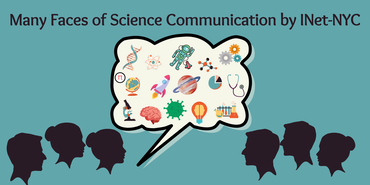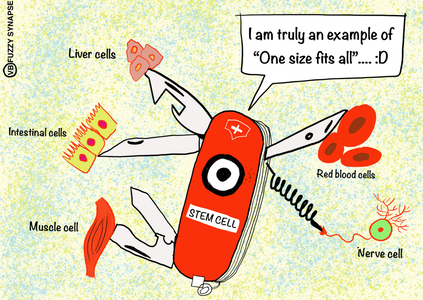|
Interview and words by: Dr. Rinki Saha Edited by: Dr. Laurie Herviou, Dr. Rupali Gund and Dr. Conchi Izquierdo  ‘One picture is worth ten thousand words.’ How many times you have thought if there was a diagram, I would have memorized this easily. Well, June is the month of effective science communication. We from INetNYC took this opportunity to launch our series where we will interview many science communicators from different backgrounds and different skill sets. This time we were lucky to interview the creator of Fuzzy Synapse – this platform explains various scientific topics in a fun and simple way. Fuzzy Synapse has covered various topics ranging from the theory of relativity while portraying the complex science behind microwave invention. 1. We would like to know the human behind the Fuzzy Synapse! I am Dr. Vinita Bharat, Neuroscientist at Stanford University. I finished my doctoral studies; being an International Max Planck Research School (IMPRS) Neuroscience student at European Neuroscience Institute, Goettingen, Germany. My research was focused on the exciting topic of how our brain learns and memorizes. Science has always been compelling to me, while doing my Ph.D. I understood the need of communicating science to the world. I started an online platform in 2017 called Fuzzy Synapse. With this platform, I create content to simplify complex scientific concepts in an easy and fun way. So, you can call me “the scientist who loves communicating science to broader audience.” 2. When did you illustrate something for science for the first time? Was there someone in particular who inspired you to start Fuzzy Synapse? I have always been keen on doodling; I would always love pictorially explaining myself any complex topic. I think visual illustration always makes a better impression on our minds. From our textbooks, we probably have forgotten many things, but some schematics are still in our minds. There is a very fun story that happened during my Ph.D which I would love to share. During those years, CRISPR was a new discovery, everyone in the scientific community was talking about it. I made some doodles explaining CRISPR technique. My friends and colleagues really liked it and encouraged me to post it on social media, and to my surprise, it really got a huge appraisal. That was kind of the starting point of my journey as a science communicator through Fuzzy Synapse. Fuzzy Synapse represented stem cell as "Swiss army knife” which basically holds the ability of multiple tools in one. To answer your second question, it’s very hard to pinpoint one artist as a role model given the variety of mediums people use to communicate science. From my initial days, Stempeers have given me great support and opportunity to grow my platform. I found amazing sci-comm artists through STEMPEERS. I love following and learning from each and every one’s art and way of science communication. To add a few more names, I enjoy science sketches, exemplary work from Dr.David Goodsell. Also, PHD comic series is something that makes me laugh every time.
3. Is there any exciting story behind the name Fuzzy Synapse? I want to give credit to my husband who coined this name for my platform. I think the connection between the world and science is fuzzy and being from a neuroscience background, connection means synapse. I think this name Fuzzy Synapse aligns very well with my interest and the mission of this platform really well. 4. The ratio between science communicators and scientists is not high: in your opinion, how should we tackle this issue? I think scientists should learn the art of communicating their science to the broader audience. Especially from this pandemic, we learned that we are not just fighting pandemic but also infodemic. Through science communication we should bring science and society closer. Describing the significance of your work without using jargon could be very difficult as we the scientists have no formal training in that. I think teaching effective science communication from the very start can help. I am working on curating a seminar series on effective science communication which might also help in this direction. 5. What software/applications are you using to work on your projects? When I started, I was simply using pen and paper to create illustrations. Now, I heavily use Procreate and Adobe illustrator to create all the artsy stuff. These softwares give more dimensions to my work but I feel the idea is the key. 6. How are you running the platform and how do you manage to balance your lab life and your passion side by side? I try to balance both sides. I aim to cover at least one scientific topic every week through Fuzzy Synapse. So far, I have covered around 170 topics through my art. I make sure to bring the science correctly, hence do my homework too before starting the idea. I also make a conscious effort to make my content more diverse and inclusive. Collaborating with amazing groups and individual contributors gives me a great opportunity to fine tune my ideas. I learned a lot in this whole process which has kept me motivated so far. I would say actually working in the lab brings a lot of ideas for Fuzzy Synapse. Let's say if I am running a Polymerase Chain Reaction (PCR) or working with stem cells, I think then to create illustrations on those topics. After a long day of work at the lab, thinking and creating these illustrations give me immense joy. I would say it’s hard keeping a balance between lab work and Fuzzy Synapse, but the oxytocin I get from this creation keeps me going. 7. What is the future for the platform Fuzzy Synapse? I am planning to launch a book series that will cover more scientific topics in greater detail. I am working on a book project called ‘draw your science’. Besides another ongoing series called “Draw your neuroscience” where I aim to make neuroscience fun and easy for all. I am aiming to soon launch a workshop series on effective science communication. I envision Fuzzy Synapse will be a collaborative platform for scientists and artists to collaborate. Be it through visual illustrations, art performances, podcasts etc., we will see an amazing amalgamation of both sides to communicate science. 8. What advice would you give to people who want to start with Science Communication? Just start, don’t complicate your thought process, don’t be hesitant. Please make sure to spread the right message through your content. It’s a learning process, so just put your ideas out. Collaborate with others in the field and keep learning and creating. To enjoy illustrations from Fuzzy Synapse follow her on Facebook , Instagram and twitter too!
0 Comments
|
Archives
May 2025
Categories
All
|


 RSS Feed
RSS Feed